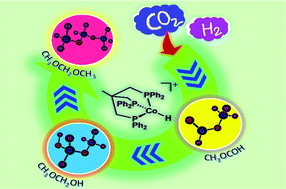Mechanistic exploration of CO2 conversion to dimethoxymethane (DMM) using transition metal (Co, Ru) catalysts: an energy span model†
Abstract
The conversion of CO2 to DMM is an important transformation for various reasons. Co and Ru-based triphos catalysts have been investigated using density functional theory (DFT) calculations to understand the mechanistic pathways of the CO2 to DMM conversion and the role of noble/non-noble metal-based catalysts. The reaction has been investigated sequentially through methylformate (MF) and methoxymethane (MM) intermediates as they are found to be important intermediates. For the hydrogenation of CO2 and MF, the hydrogen sources such as H2 and methanol have been investigated. The calculated reaction free energy barriers for all the possible pathways suggest that both hydrogen sources are important for the Co-triphos catalyst. However, in the case of the Ru-triphos catalyst, molecular H2 is calculated to be the only hydrogen source. Various esterification and acetalization possibilities have also been explored to find the most favorable pathway for the conversion of CO2 to DMM. We find that the hydride transfer to the CO2 is the rate determining step (RDS) for the overall reaction. Our mechanistic investigation reveals that the metal center is the active part for the catalysis rather than the Brønsted acid and the redox triphos ligand plays an important role through the push–pull mechanism. The implemented microkinetic study shows that the reaction is also quite dependent on the concentration of the gaseous reactants and the rate constant increases exponentially above 363 K.



 Please wait while we load your content...
Please wait while we load your content...